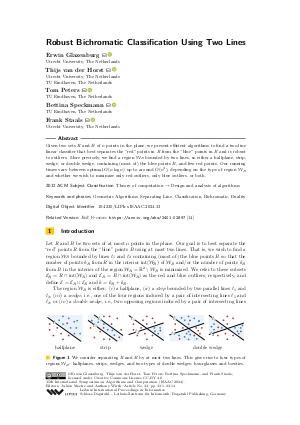Robust Bichromatic Classification Using Two Lines
Authors
Erwin Glazenburg  ,
Thijs van der Horst
,
Thijs van der Horst  ,
Tom Peters
,
Tom Peters  ,
Bettina Speckmann
,
Bettina Speckmann  ,
Frank Staals
,
Frank Staals 
-
Part of:
Volume:
35th International Symposium on Algorithms and Computation (ISAAC 2024)
Part of: Series: Leibniz International Proceedings in Informatics (LIPIcs)
Part of: Conference: International Symposium on Algorithms and Computation (ISAAC) - License:
 Creative Commons Attribution 4.0 International license
Creative Commons Attribution 4.0 International license
- Publication Date: 2024-12-04
File

PDF
LIPIcs.ISAAC.2024.33.pdf
- Filesize: 1 MB
- 14 pages
Document Identifiers
Related Versions
- Full Version https://arxiv.org/abs/2401.02897
Subject Classification
ACM Subject Classification
- Theory of computation → Design and analysis of algorithms
Keywords
- Geometric Algorithms
- Separating Line
- Classification
- Bichromatic
- Duality
Metrics
- Access Statistics
-
Total Accesses (updated on a weekly basis)
0PDF Downloads0Metadata Views
Abstract
Given two sets R and B of n points in the plane, we present efficient algorithms to find a two-line linear classifier that best separates the "red" points in R from the "blue" points in B and is robust to outliers. More precisely, we find a region 𝒲_B bounded by two lines, so either a halfplane, strip, wedge, or double wedge, containing (most of) the blue points B, and few red points. Our running times vary between optimal O(nlog n) up to around O(n³), depending on the type of region 𝒲_B and whether we wish to minimize only red outliers, only blue outliers, or both.
Cite As Get BibTex
Erwin Glazenburg, Thijs van der Horst, Tom Peters, Bettina Speckmann, and Frank Staals. Robust Bichromatic Classification Using Two Lines. In 35th International Symposium on Algorithms and Computation (ISAAC 2024). Leibniz International Proceedings in Informatics (LIPIcs), Volume 322, pp. 33:1-33:14, Schloss Dagstuhl – Leibniz-Zentrum für Informatik (2024)
https://doi.org/10.4230/LIPIcs.ISAAC.2024.33
BibTex
@InProceedings{glazenburg_et_al:LIPIcs.ISAAC.2024.33,
author = {Glazenburg, Erwin and van der Horst, Thijs and Peters, Tom and Speckmann, Bettina and Staals, Frank},
title = {{Robust Bichromatic Classification Using Two Lines}},
booktitle = {35th International Symposium on Algorithms and Computation (ISAAC 2024)},
pages = {33:1--33:14},
series = {Leibniz International Proceedings in Informatics (LIPIcs)},
ISBN = {978-3-95977-354-6},
ISSN = {1868-8969},
year = {2024},
volume = {322},
editor = {Mestre, Juli\'{a}n and Wirth, Anthony},
publisher = {Schloss Dagstuhl -- Leibniz-Zentrum f{\"u}r Informatik},
address = {Dagstuhl, Germany},
URL = {https://drops.dagstuhl.de/entities/document/10.4230/LIPIcs.ISAAC.2024.33},
URN = {urn:nbn:de:0030-drops-221605},
doi = {10.4230/LIPIcs.ISAAC.2024.33},
annote = {Keywords: Geometric Algorithms, Separating Line, Classification, Bichromatic, Duality}
}
Author Details
References
- Charu C. Aggarwal, editor. Data Classification: Algorithms and Applications. CRC Press, 2014. URL: https://doi.org/10.1201/B17320.
- Carlos Alegría, David Orden, Carlos Seara, and Jorge Urrutia. Separating bichromatic point sets in the plane by restricted orientation convex hulls. Journal of Global Optimization, 85(4):1003-1036, 2023. URL: https://doi.org/10.1007/s10898-022-01238-9.
- Edoardo Amaldi and Viggo Kann. The complexity and approximability of finding maximum feasible subsystems of linear relations. Theoretical Computer Science, 147(1&2):181-210, 1995. URL: https://doi.org/10.1016/0304-3975(94)00254-G.
- Esther M. Arkin, Delia Garijo, Alberto Márquez, Joseph S. B. Mitchell, and Carlos Seara. Separability of point sets by k-level linear classification trees. International Journal of Computational Geometry & Applications, 22(2):143-166, 2012. URL: https://doi.org/10.1142/S0218195912500021.
- Esther M. Arkin, Ferran Hurtado, Joseph S. B. Mitchell, Carlos Seara, and Steven Skiena. Some lower bounds on geometric separability problems. International Journal of Computational Geometry & Applications, 16(1):1-26, 2006. URL: https://doi.org/10.1142/S0218195906001902.
- Bogdan Armaselu and Ovidiu Daescu. Dynamic minimum bichromatic separating circle. Theoretical Computer Science, 774:133-142, 2019. URL: https://doi.org/10.1016/j.tcs.2016.11.036.
- Boris Aronov, Delia Garijo, Yurai Núñez Rodríguez, David Rappaport, Carlos Seara, and Jorge Urrutia. Minimizing the error of linear separators on linearly inseparable data. Discrete Applied Mathematics, 160(10-11):1441-1452, 2012. URL: https://doi.org/10.1016/j.dam.2012.03.009.
- Timothy M. Chan. Low-dimensional linear programming with violations. SIAM Journal on Computing, 34(4):879-893, 2005. URL: https://doi.org/10.1137/S0097539703439404.
- Timothy M. Chan. Optimal partition trees. Discrete & Computational Geometry, 47(4):661-690, 2012. URL: https://doi.org/10.1007/s00454-012-9410-z.
- Bernard Chazelle and Emo Welzl. Quasi-optimal range searching in space of finite vc-dimension. Discret. Comput. Geom., 4:467-489, 1989. URL: https://doi.org/10.1007/BF02187743.
-
Mark de Berg, Otfried Cheong, Marc J. van Kreveld, and Mark H. Overmars. Computational geometry: algorithms and applications, 3rd Edition. Springer, 2008.

- Hazel Everett, Jean-Marc Robert, and Marc van Kreveld. An optimal algorithm for the (≤ k)-levels, with applications to separation and transversal problems. In Proceedings of the ninth annual symposium on Computational geometry, pages 38-46, 1993. URL: https://doi.org/10.1145/160985.160994.
- Erwin Glazenburg, Frank Staals, and Marc van Kreveld. Robust classification of dynamic bichromatic point sets in r2, 2024. https://arxiv.org/abs/2406.19161, URL: https://doi.org/10.48550/arXiv.2406.19161.
- Erwin Glazenburg, Thijs van der Horst, Tom Peters, Bettina Speckmann, and Frank Staals. Robust bichromatic classification using two lines, 2024. https://arxiv.org/abs/2401.02897, URL: https://doi.org/10.48550/arXiv.2401.02897.
- Sariel Har-Peled and Vladlen Koltun. Separability with outliers. In Proc. 16th International Symposium on Algorithms and Computation, volume 3827 of Lecture Notes in Computer Science, pages 28-39. Springer, 2005. URL: https://doi.org/10.1007/11602613_5.
- Ferran Hurtado, Mercè Mora, Pedro A. Ramos, and Carlos Seara. Separability by two lines and by nearly straight polygonal chains. Discrete Applied Mathematics, 144(1-2):110-122, 2004. URL: https://doi.org/10.1016/j.dam.2003.11.014.
- Ferran Hurtado, Marc Noy, Pedro A. Ramos, and Carlos Seara. Separating objects in the plane by wedges and strips. Discrete Applied Mathematics, 109(1-2):109-138, 2001. URL: https://doi.org/10.1016/S0166-218X(00)00230-4.
- Ferran Hurtado, Carlos Seara, and Saurabh Sethia. Red-blue separability problems in 3D. International Journal of Computational Geometry & Applications, 15(2):167-192, 2005. URL: https://doi.org/10.1142/S0218195905001646.
- Nimrod Megiddo. Linear programming in linear time when the dimension is fixed. Journal of the ACM, 31(1):114-127, 1984. URL: https://doi.org/10.1145/2422.322418.
- D. Sculley and Gabriel M. Wachman. Relaxed online SVMs for spam filtering. In Proc. 30th Annual International ACM SIGIR Conference on Research and Development in Information Retrieval, SIGIR ’07, pages 415-422. Association for Computing Machinery, 2007. URL: https://doi.org/10.1145/1277741.1277813.
-
Carlos Seara. On geometric separability. PhD thesis, Univ. Politecnica de Catalunya, 2002.

-
Aihua Shen, Rencheng Tong, and Yaochen Deng. Application of classification models on credit card fraud detection. In Proc. 2007 International conference on service systems and service management, pages 1-4. IEEE, 2007.

